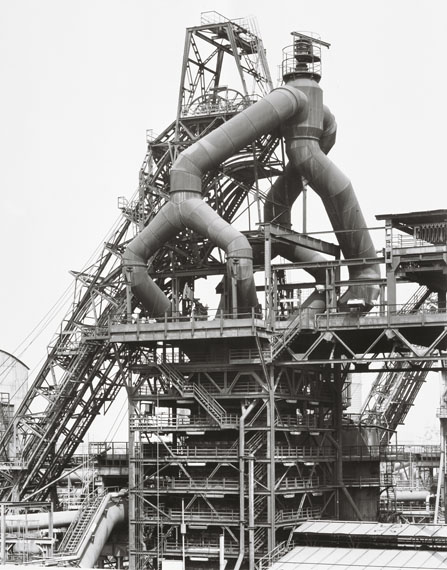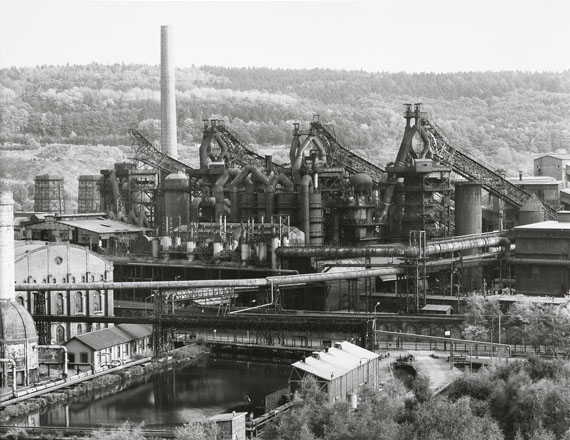Bernd & Hilla Becher »
Blast Furnaces
Hochofenwerke
Exhibition: 20 Sep 2013 – 26 Jan 2014
Thu 19 Sep 19:00
Die Photographische Sammlung / SK Stiftung Kultur
Im Mediapark 7
50670 Köln
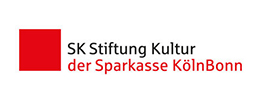
Die Photographische Sammlung / SK Stiftung Kultur, Köln
Im Mediapark 7
50670 Köln
+49 (0)221-88895300
photographie@sk-kultur.de
www.photographie-sk-kultur.de
Thu-Tue 14-19
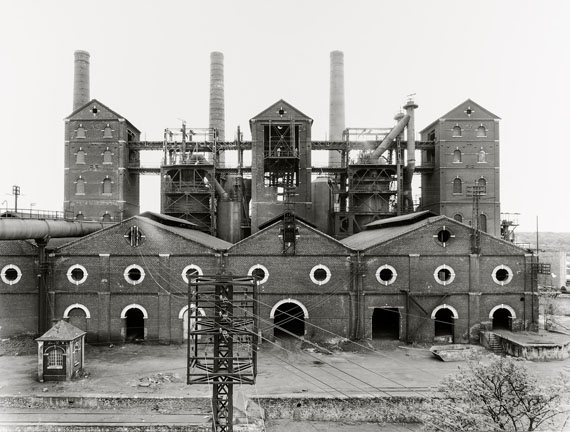
Bernd and Hilla Becher
Blast Furnaces
Exhibition: September 20, 2013 — January 26, 2014
Opening: Thursday September 19, 7 p.m.
Strikingly plastic and almost model-like, the blast furnace plants with their large-scale equipment, developed over decades, demonstrate the often-cited ideal of “form follows function.” For the operators of such plants are guided less by aesthetic principles and more– allowing for the specific conditions in situ–by considerations with respect to technical and economic optimization that extend into the beginning of the new millennium. In terms of their construction and function, it is possible to closely relate to the structures Bernd and Hilla Becher viewed through the lens of a large-format camera. The blast furnace and the blast furnace head were, to the extent that the prevailing circumstances permitted, often photographed from three or even four sides, so that the image sequence conveys an overall view of the respective object–from the front, from the sides, and in perspective. An analytical approach deliberately borrowed from the natural sciences and which, when transferred to other utility buildings in the Bechers’ oeuvre, repeatedly turns up. This allows one to visually pass through the blast furnace plant and understand large areas of it. Even closer shots depict various pipe elements, for example, required for redirecting wind and gas, as well as constructions and details. Their volume and elementary forms, their materiality and tonality are striking. They stimulate our imagination; possess their own aesthetic, almost ornamental force, and dynamism; and at the same time give us a sense of the far-reaching engineering and technical achievements that over the decades constantly lead to the refitting and redesign of blast furnace plants.
Now, for the first time, an opportunity is being presented to view and compare the extensively compiled series of photographs of different blast furnaces taken by the artist couple during their numerous travels through Germany, Belgium, Luxembourg, France, and the United States. The exhibition presents about two-hundred and fifty of the black-and-white images of more than forty-five blast furnaces taken since the sixties; series of photographs and individual large- format pictures that were assembled for under the direction of Hilla Becher, or new prints made on the basis of the original negative archives. The series are devoted to, for example, the German blast furnaces in Duisburg- Bruckhausen, Völklingen, Lübeck, or in Eisenhüttenstadt; the French plants in Longwy, Rombas, or Neuves-Maisons; the furnaces in Liège-Seraing, Charleroi, and La Louvière in Belgium or in Terre Rouge and Differdingen in Luxembourg; as well as facilities in the American towns of Ensley, Fairfield, Gadsden, Mingo Junction, Aliquippa und Youngstown.
Some of them have meanwhile been decommissioned, converted, or even declared industrial monuments, while others are still in operation. What they share is their power to generate a sense of identity: the monumental plants not only inform the characteristic landscape of a region, there are also strong ties to the history of a region or of the country. This becomes particularly evident in Bernd and Hilla Becher’s large-format landscape photographs, which feature sprawling, large-scale industrial facilities. One recognizes not only gigantic, towering structures and smokestacks, but also the environment, the transport connections, fallow land and fields, as well as adjacent gardens and residential buildings, thus opening up numerous dimensions.
The exhibition gives an in-depth impression of the Bechers’ lasting and intense involvement with the theme of blast furnace plants. As early as 1990, they presented 223 typologically arranged photographs taken at numerous international plants in their book Hochöfen (Blast Furnaces). The current exhibition project furthermore provides an opportunity to get to know additional photographs from this context, images that were produced at the same time or later that deal even more exhaustively with blast furnaces and until recently were partially only available as negatives. Thus, emphasis is placed on a newly arranged or extended sequencing by means of what are in part new prints. However, it is an order that is inherent in the negative material, meaning one that goes hand in hand with the process of taking photographs, with the Bechers’ fundamental perspective and photographic stance. Bernd and Hilla Becher created this compositional order in collaboration, and following Bernd Becher’s death in 2007 his partner continues to pursue it.
This is the fourth exhibition project mounted by Die Photographische Sammlung/SK Stiftung Kultur featuring works by the Bechers. The first three projects were devoted to the presentation of various mines, including the Concordia and Hannover coal mines in the Ruhr region. With the blast furnace plants, light is being thrown on a further range of motifs that occupies a prominent place in our collection. The SK Stiftung Kultur foundation has closely cooperated with the artist couple for twelve years, focusing on the documentation of the entire spectrum of industrial plants they deal with in their oeuvre as well as the systematic assessment of their archive, which in more than fifty years of consistent photographic activity has grown to become an enormous and irreplaceable accumulation of image material.
Bernd and Hilla Becher devoted themselves to a variety of industrial architecture: water towers, cooling towers, gasometers, winding towers, processing plants, gravel works and stone-breaking works, lime kilns, grain elevators, and factory halls. The blast furnaces are something special within this series. They described it as follows in their 1990 book: “With some large industrial structures aesthetic additions are possible to a certain extent, but with blast furnaces heat, pressure, and gas generation overrule aesthetics. The blast furnace is like a body without a skin. Its insides are visible from the outside, organs, arteries and skeleton create its form.”
Please note the following dates:
October 10, 2013, 6:00 p.m.
Presentation of selected groups of works from the collection of Die Photographische Sammlung/SK Stiftung Kultur on the theme of industrial photography, with works by Albert Renger-Patzsch, Horst Lang, Peter Weller, August Sander, et al. (in German)
Location: Study room of Die Photographische Sammlung/SK Stiftung Kultur, 2nd floor (advanced registration is requested, maximum of 15 participants, alternative dates will be made available on request; directed by Gabriele Conrath-Scholl and Claudia Schubert)
Admission: 5 Euro
Thursday 21 November 2013, 6 p.m.
Guided Tour on Technology (in German)
Adalbert Zirkler, long-term employee at ThyssenKrupp Steel AG, who works free-lance since his retirement at the Visitors Centre at ThyssenKrupp Steel Europe AG, will use the photos in the exhibition to explain the technology of blast furnaces and steel processing.
Location: Die Photographische Sammlung. Exhibition rooms | Entrance: 5 Euro
December 5, 2013, 7:00 p.m.
“Der Schritt vom Photo zum Photobuch ist ganz logisch und folgerichtig” (“The move from the photograph to the photo book is quite logical and consistent,” Hilla Becher, 2013), panel discussion between Hilla Becher and Lothar Schirmer, moderated by Gabriele Conrath-Scholl, followed by a book signing with Hilla Becher. (in German)
Location: Auditorium, 1st floor, Im Mediapark 7, 50670 Cologne.
Admission: Euro 7 (Euro 4,50 conc.)
Thursday 16 January 2014, 6 p.m.
Guided Tour on Technology (in German)
Adalbert Zirkler, long-term employee at ThyssenKrupp Steel AG, who works free-lance since his retirement at the Visitors Centre at ThyssenKrupp Steel Europe AG, will use the photos in the exhibition to explain the technology of blast furnaces and steel processing.
Location: Die Photographische Sammlung. Exhibition rooms | Entrance: 5 Euro�
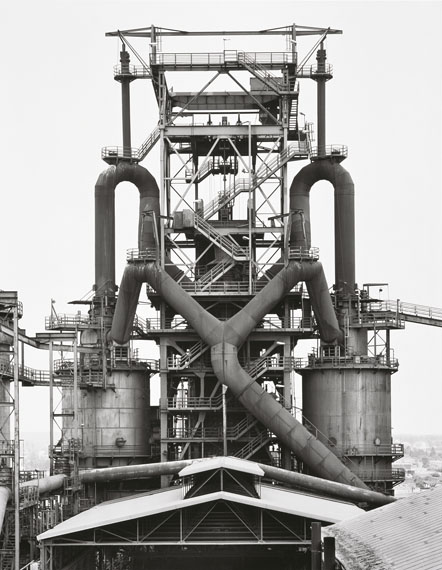
Bernd und Hilla Becher
Hochofenwerke
Ausstellung: 20. September 2013 bis 26. Januar 2014
Eröffnung: Donnerstag, 19. September, 19 Uhr
Beeindruckend plastisch, fast modellhaft veranschaulichen die Hochofenanlagen mit ihren über Jahrzehnte entwickelten Großapparaturen das vielzitierte Ideal „Form folgt Funktion“. Denn die Betreiber jener Anlagen sind weniger von ästhetischen Prinzipien, als vielmehr — die spezifischen Standortbedingungen berücksichtigend — von Überlegungen technischer und wirtschaftlicher Optimierung geleitet, die bis in den Beginn des neuen Jahrtausends reichen. Die von Bernd und Hilla Becher via Großformatkamera betrachteten und studierten Bauten lassen sich in Konstruktion und Funktion genau nachvollziehen. Der Hochofen und der Hochofenkopf wurden oft — sofern die Aufnahmesituation dies zulässt — von drei oder gar vier Seiten ins Bild gesetzt, so dass die Bildsequenz eine Abwicklung des jeweiligen Objekts wiedergibt — frontal, seitlich und perspektivisch gesehen. Eine analytische Sichtweise, die sich absichtsvoll im Naturwissenschaftlichen begründet und immer wieder, übertragen auch auf andere Funktionsbauten im Werk der Bechers, wiederfindet. Ein Hochofenwerk kann damit visuell durchschritten und in weiten Bereichen nachvollzogen werden. Nochmals nahsichtiger werden unterschiedliche, zum Beispiel für die Weiterleitung von Wind und Gas notwendige Röhrenelemente, Konstruktionen und Details abgebildet. Sie beeindrucken durch ihr Volumen und ihre elementaren Formen ebenso wie ihre Materialität und Tonalität. Sie regen unsere Phantasie an, besitzen eine eigene Ästhetik, fast ornamentale Kraft und Dynamik und lassen zugleich weitreichende Ingenieurs- und Handwerkerleistungen erahnen, die die Hochofenwerke über Jahrzehnte immer wieder neu überholen und gestalten.
Erstmals bietet sich nun Gelegenheit, die vom Künstlerpaar auf vielen Reisen in Deutschland, Belgien, Luxemburg, Frankreich und in den USA höchst umfangreich erarbeiteten Bildreihen unterschiedlicher Hochofenwerke im nahen Vergleich zu betrachten. Die Präsentation stellt rund 250 seit den 1960er-Jahren entstandene Schwarzweißaufnahmen von über 45 Hochofenwerken vor; Bildreihen und großformatige Einzelphotographien, die für die Photographische Sammlung/SK Stiftung Kultur unter der Regie von Hilla Becher zusammengestellt bzw. auf Grundlage des originalen Negativarchivs neu abgezogen wurden. Die Bildreihen widmen sich beispielsweise den deutschen Hochofenanlagen in Duisburg-Bruckhausen, Völklingen, Lübeck oder in Eisenhüttenstadt, den französischen Werken in Longwy, Rombas oder Neuves-Maisons, den belgischen in Liège-Seraing, Charleroi und La Louvière, in Luxemburg Terre Rouge und Differdingen sowie in den USA Ensley, Fairfield, Gadsden, Mingo Junction, Aliquippa und Youngstown.
Einige der Hochofenwerke wurden inzwischen abgebrochen, umgenutzt oder sogar zu Industriedenkmalen ernannt, andere produzieren noch. Gemeinsam ist ihnen eine hohe identitätsstiftende Kraft, formen die monumentalen Werksanlagen nicht allein das Landschaftsbild einer Gegend, auch die Geschichte eines Ortes oder des Landes ist damit verbunden. Besonders die von Bernd und Hilla Becher großformatig umgesetzten Landschaftsbilder, die ausladende großflächige Industrieanlagen zeigen, machen dies deutlich. Nicht allein die zum Himmel ragenden gigantischen Bauten und Kamine sind zu erkennen, sondern auch das Umfeld, die Verkehrsanbindung, Brachen und Felder sowie angrenzende Gärten und Wohnbauten. Damit eröffnen sich viele Dimensionen zur Betrachtung.
Die Ausstellung vermittelt ein umfassendes Bild von der fortwährend intensiven Beschäftigung Bechers mit dem Thema der Hochofenwerke. Bereits 1990 konnten sie in ihrem Buch "Hochöfen" in 223 Tafeln ihre typologisch geordneten Ansichten, aufgenommen in zahlreichen internationalen Hochofenwerken, vor Augen führen. Mit dem aktuellen Ausstellungsprojekt bekommt man darüber hinaus Gelegenheit, weitere Bilder aus diesem Kontext kennenzulernen; solche, die parallel oder später entstanden, jene die die Hochofenanlagen erschöpfender noch behandeln und teilweise bislang nur als Negativmaterial vorlagen. Die Betonung liegt also auf einer neu entworfenen oder erweiterten Sequenzierung durch teilweise neu abgezogene Motive. Dabei ist es aber eine Ordnung, die dem Negativmaterial inhärent ist, eine solche also, die bereits mit dem Aufnahmeprozess, mit Bechers grundsätzlicher Perspektive und photographischer Haltung einhergeht. Diese kompositorische Ordnung wurde von Bernd und Hilla Becher gemeinsam geschaffen und nach Bernd Bechers Tod (2007) von seiner Partnerin weiter fortgesetzt.
Die Ausstellung ist das vierte Projekt, das die Photographische Sammlung/SK Stiftung Kultur mit den Arbeiten der Bechers durchführt. Die ersten drei Projekte waren der Darstellung unterschiedlicher Bergwerksanlagen gewidmet, darunter die Zeche Concordia und die Zeche Hannover aus dem Ruhrgebiet. Mit den Hochofenanlagen wird ein anderer wichtiger Motivkreis beleuchtet, der im hauseigenen Sammlungsbestand prominent vertreten ist. Seit zwölf Jahren verbindet die Stiftung mit dem Künstlerpaar eine enge Kooperation, die sich auf das Thema der Dokumentation gesamter Industrieanlagen in ihrem Schaffen richtet ebenso wie auf die systematische Aufarbeitung ihres Archivs, das in über 50 Jahren konsequent photographischer Tätigkeit zu einem enormen und unersetzlichen Fundus angewachsen ist.
Bitte merken Sie sich folgende Termine vor:
Donnerstag, 10. Oktober 2013, 18 Uhr
Präsentation ausgewählter Werkgruppen aus dem Bestand der Photographischen Sammlung/SK Stiftung Kultur zum Thema der Industriephotographie mit Werken von Albert Renger-Patzsch, Horst Lang, Peter Weller, August Sander u. a.
Ort: Studienraum der Photographischen Sammlung/SK Stiftung Kultur, 2. Stock (Voranmeldung erbeten, max. 15 Personen – auf Nachfrage werden auch weitere Ausweichtermine angeboten, Leitung: Gabriele Conrath-Scholl und Claudia Schubert)
Eintritt: Euro 5
Donnerstag, 21. November 2013, 18 Uhr
Technikführung durch die Ausstellung
Adalbert Zirkler, langjähriger Mitarbeiter der ThyssenKrupp Steel AG und seit seiner Pensionierung freiberuflicher Mitarbeiter im BesucherCentrum der ThyssenKrupp Steel Europe AG, erklärt anhand der Bilder in der Ausstellung die Technik der Hochöfen und der Stahlveredlung.
Ort: Die Photographische Sammlung, Ausstellungsräume | Eintritt: Euro 5
Donnerstag, 5. Dezember 2013, 19 Uhr
"Der Schritt vom Photo zum Photobuch ist ganz logisch und folgerichtig" (Hilla Becher, 2013), Podiumsgespräch zwischen Hilla Becher und Lothar Schirmer, moderiert von Gabriele Conrath-Scholl. Anschließend Signierstunde mit Hilla Becher.
Ort: Saal 1. Stock, Im Mediapark 7
Eintritt: Euro 7, erm. Euro 4,50
Donnerstag, 16. Januar 2014, 18 Uhr
Technikführung durch die Ausstellung
Adalbert Zirkler, langjähriger Mitarbeiter der ThyssenKrupp Steel AG und seit seiner Pensionierung freiberuflicher Mitarbeiter im BesucherCentrum der ThyssenKrupp Steel Europe AG, erklärt anhand der Bilder in der Ausstellung die Technik der Hochöfen und der Stahlveredlung.
Ort: Die Photographische Sammlung, Ausstellungsräume | Eintritt: Euro 5�
